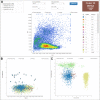Managing Multi-center Flow Cytometry Data for Immune Monitoring
- PMID: 26085786
- PMCID: PMC4463798
- DOI: 10.4137/CIN.S16346
Managing Multi-center Flow Cytometry Data for Immune Monitoring
Abstract
With the recent results of promising cancer vaccines and immunotherapy1-5, immune monitoring has become increasingly relevant for measuring treatment-induced effects on T cells, and an essential tool for shedding light on the mechanisms responsible for a successful treatment. Flow cytometry is the canonical multi-parameter assay for the fine characterization of single cells in solution, and is ubiquitously used in pre-clinical tumor immunology and in cancer immunotherapy trials. Current state-of-the-art polychromatic flow cytometry involves multi-step, multi-reagent assays followed by sample acquisition on sophisticated instruments capable of capturing up to 20 parameters per cell at a rate of tens of thousands of cells per second. Given the complexity of flow cytometry assays, reproducibility is a major concern, especially for multi-center studies. A promising approach for improving reproducibility is the use of automated analysis borrowing from statistics, machine learning and information visualization21-23, as these methods directly address the subjectivity, operator-dependence, labor-intensive and low fidelity of manual analysis. However, it is quite time-consuming to investigate and test new automated analysis techniques on large data sets without some centralized information management system. For large-scale automated analysis to be practical, the presence of consistent and high-quality data linked to the raw FCS files is indispensable. In particular, the use of machine-readable standard vocabularies to characterize channel metadata is essential when constructing analytic pipelines to avoid errors in processing, analysis and interpretation of results. For automation, this high-quality metadata needs to be programmatically accessible, implying the need for a consistent Application Programming Interface (API). In this manuscript, we propose that upfront time spent normalizing flow cytometry data to conform to carefully designed data models enables automated analysis, potentially saving time in the long run. The ReFlow informatics framework was developed to address these data management challenges.
Keywords: Flow cytometry; REST API; automated analysis; data management; data provenance; laboratory informatics; metadata; reproducible analysis.
Figures










References
-
- Higano CS, Schellhammer PF, Small EJ, et al. Integrated data from 2 randomized, double-blind, placebo-controlled, phase 3 trials of active cellular immunotherapy with sipuleucel-T in advanced prostate cancer. Cancer. 2009;115:3670–9. - PubMed
-
- Kenter GG, Welters MJ, Valentijn AR, et al. Vaccination against HPV-16 oncoproteins for vulvar intraepithelial neoplasia. N Engl J Med. 2009;361:1838–47. - PubMed
-
- Walter S, Weinschenk T, Stenzl A, et al. Multipeptide immune response to cancer vaccine IMA901 after single-dose cyclophosphamide associates with longer patient survival. Nat Med. 2012;18:1254–61. - PubMed
Grants and funding
LinkOut - more resources
Full Text Sources
Other Literature Sources

